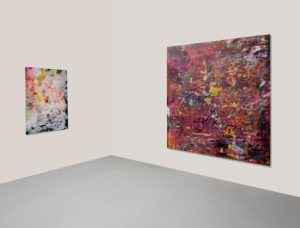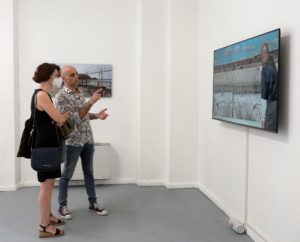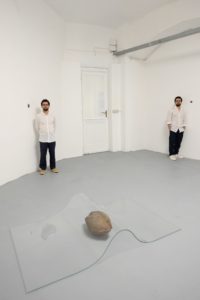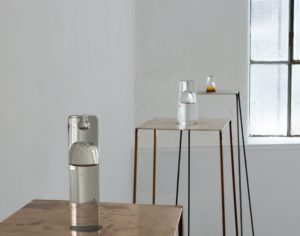Michelangelo Pistoletto and Giorgio Verzotti, the artist and the curator, face to face in an informal and immersive conversation focusing on the group exhibition Four (Not So) Easy Pieces, curated by Verzotti in collaboration with the Woolbridge Gallery, a creative space occupying part of the former Lanificio Pria in Biella. The relationship between Fondazione Pistoletto and the gallery directed by Jean le Guyader and Patrick Saletta was established in November 2021, with the participation of Pistoletto in the exhibition Zona Bianca Zero, held in the Woolbridge spaces. Four artists featured in that exhibition were then chosen by Pistoletto and given the opportunity to display their works at Cittadellarte, as a way of fostering collaboration between the foundation and other Biellese art centres. As reported in a previous article, Four (Not So) Easy Pieces opened on the occasion of Arte al Centro 2022 and includes works by the following artists: Massimo De Caria, whose sculptures consisting in minimal, almost sensory, reliefs appear next to his works created juxtaposing glass, water and metals; Daniele Innamorato, who, on the strength of his skills as a photographer and graphic designer, created an impetuous painting on large canvas, characterised by a vitality of colours; Filippo Berta, who has proposed a video entitled “Gente Comune” (Ordinary People), whose footage confronts the observer with the divisions and inequalities of a despotic and oppressive globalised world; finally, Carlo and Fabio Grassia have combined the technical skill of reproducing tiny pieces of reality in minute drawings with great inventiveness in attributing metaphorical values and profound meanings to the plastic materials with which they create sculptures and installations.
You can find out more about the contents of the exhibition in the following exchange between Pistoletto and Verzotti.

Michelangelo Pistoletto: Shall we start with the title? Why “Four (Not So) Easy Pieces”?
Giorgio Verzotti: I didn’t really know how to read such different works, so I thought of a title that would straight away allude to the differences, four different artists, four pieces… I immediately thought of the book by Richard P. Feynmann, the physicist, called “Six Easy Pieces”, easy in the sense that his essay is written for ordinary people. In our case, however, the ‘pieces’ are not so easy, so I added the parenthesis which also gives an ironic tone to the whole thing and seems appropriate. Also because Feynmann’s book may be easy, but I didn’t understand it anyway.

Pistoletto: Doesn’t he talk about particle physics? About microstructures?
I think this is an appropriate key to interpret the works of Carlo and Fabio Ingrassia, Massimo De Caria, Filippo Berta and Daniele Innamorato. For example, Carlo and Fabio, the Sicilian twins: to me, their minute pencil work seems almost like biotechnology, an organic practice. Speaking of microstructures, think of the formation of cells: I see the two of them as a biological phenomenon, they are a cell divided into two which is recomposed in the work. In the work of art, in fact, their twinning continually recomposes itself, as in the same egg… Without their twin biology, such a work would not exist. Then there is the technology, I would say that Carlo and Fabio translate biology into technology.
Verzotti: Hours of work at the drawing table holding a magnifying glass, with a pencil each, working on a very small surface and creating those perfect images. One defines the sign and the other joins it, as they say. One of them is left-handed. Yes, I also see them as one organism articulated in two complementary functions.
Pistoletto: Exactly, and I find it interesting that it is this physiology to produce images. There is the imaginative phenomenon of painting, with its ancient origins, and then there is the artistic representation. If I take that microlandscape they made in pencil, it looks like a perfect photographic reproduction: you look at it and think “this is a photograph”, they are all very small and perfect images. However, if we could enlarge them, expand them to macroscopic size, we would see all the dots, and the marks they have traced, we would discover matter and its phenomenology, the cellular tissue that here creates an image instead of forming a body. By examining the technique of these works, we can understand how physics and chemistry work by relationship. I see this practice as an example of generation of a physical being. You said “not so easy”: it is fair to say that, it is consistent with their work from its practice.
Verzotti: There is the idea of transformation, of the transformative creation of the existing, acted out right down to the microstructure, and this is a common trait with Massimo De Caria. Even in his case, it is not easy to define his work once and for all because the combination of his metals and natural elements – water, in this case – will always give different results. The process remains unique, the work as an ongoing process.

Pistoletto: De Caria interrogates the three-dimensionality of sculpture in the same way that the Ingrassia twins interrogate the image in its two-dimensionality, and refer back to painting. Here, the chemical reaction is integral part of the work in the sense that there is no representation, neither at the beginning nor at the end of the process, there is the process, the transformation. I am interested in this work because I find in it a confirmation of what I think, which is that Arte Povera was not so much a movement as a founding idea or intention of art.
Verzotti: A vision?
Pistoletto: Yes, a vision of art which is no longer an idealised transposition in the constitution of the work but there is the being, the becoming of things, there is radicality in the sense of the root, there is the essence of things. For me, this was the fundamental reason for Arte Povera, the transition from representing to being. These sculptures interest me because they are very close to the trinamic concept: they are elements that, connected, produce something new, they are creation understood as direct implementation. Or more precisely the ‘enactment’ of creation. The Arte Povera artists created very different works, but each had this quality: to be phenomenologically essential. I see the same attitude in the works of these four artists. My choice of bringing them to the exhibition here at Cittadellarte was not based on reasoning, but on the direct, immediate perception of a phenomenology that unites art to what exists.
Verzotti: And what about Filippo Berta’s video?
Pistoletto: He has translated the dramatic tension of the border from an element of separation and war between two countries into a third element that replaces the contrast with a suspension of time and space. Berta eliminates the conflict by slowing down the time of its impact. He scans the words in the languages of the different countries, transferring them into sequences of instants. He creates a fourth dimension through time, which in his video unifies what space separates. And he distances and distributes the narrow temporal frequencies inherent in the logic of war over long periods of time. Instant by instant, word by word, he introduces a temporal dynamic that transcends the dimension of opposing spaces.
Verzotti: Can we say that in Berta the formative processes that we see in Carlo and Fabio Ingrassia and in Massimo De Caria become interpersonal relationships that we can symbolically read as social dynamics
Pistoletto: I would not only say symbolically, but also in actual reality. Berta starts from the different languages of the different people and brings everything down to the lowest denominator, which are the sharp points of the barbed wire, the elements carrying the offence, and each of them is counted and assigned a number that gives it an individuality humanised by the voice of a person; at the same time, all these individualities are included in a very broad concept of humanity. Here, too, like in the Ingrassias’ drawings, we have a microdimension extended to a global level. Micro and macro brought together!
Verzotti: You see that physics returns!
Pistoletto: Yes, and it also returns in the work of Daniele Innamorato.
Abstract painting of sign and colour, we’ve seen a lot of that, haven’t we? But I had never seen such abstract painting: I find in it components that go beyond the brushstroke, the dripping, the expanse of colour, the juxtaposition or contrast of tones, the multiplicity of signs that can be more or less undone; here we have small conventions, each sign carries a small convention, like brands. There is no explosion of colours and signs, there is no formal blooming. To me, these works are like Carlo and Fabio Ingrassia’s landscapes or Filippo Berta’s performance art. If I look closely, I don’t mean under the microscope but very closely, I see signs that already mean something in themselves, that are intrinsically emblematic, that are part of a system of conventions which, freed from other contexts and brought together in always different ways, create something new. Colour itself is unleashed by these conventions, it is the convention of colour that creates a new harmony. This is a musical work composed of conventional data. The sign here is not pictorial, the composition is never expressive; if it were, I would have said: “Ah, yes, of course, we know it”, and I would not have been surprised, whereas I see something here that I did not know instead

Verzotti: A musical work is in fact composed of notes, always the same seven, which are pure conventions in our culture, but which generate infinite different melodies. In fact, Innamorato is not expressive, when he throws colour onto the canvas he knows very well that we have had Pollock, he does not express himself; if anything, he confronts painting and its history, which is actually based on linguistic conventions.
Pistoletto: I speak of convention as a concept of art that defines its essence and phenomenology.
Verzotti: You were talking about the microscope, I would say that all four of these types of work could be seen through a microscope in the sense that each one, in its own way, contains a secret reality, a microstructure that underpins it, and I am speaking both technically and metaphorically…
Pistoletto: I would say that each one of them, in its own way, looks into the phenomenology of materials as well as analysing the mechanisms of creation.
Verzotti: This exhibition was born out of a contingency, out of a chance encounter between you and the four artists at the time of the exhibition at the Woolbridge Gallery, not far from here. But you can detect affinities between them, chosen, as you said, more intuitively than through reasoning. At the opening of the exhibition, in July, I spoke of intuition myself. Cittadellarte itself was born out of your artistic intuition, which over time has not only created works of art, but also human relations, collaboration, a collective activity that led to the Third Paradise and has generated a social dynamic involving the institutions. So I thought it was fair to say that in the exhibition we offered the public four different declinations of this intuition, artistic intuition at its inception…
Pistoletto: I associate artistic intuition with that of the scientist, who always starts with an idea, a hypothesis, and then verifies it with research, which can lead to discovery. I always say that art is the enzyme of thought, which is born from artistic intuition and then continues to ferment, generating all the other forms of knowledge. Yes, it is true, you can see intuition in all phases of my work, of my research. I have been asked if I am happy to want to change the world with art, and I answered that I am trying to change it, I am working on it, and the very fact of working on it makes me happy.

